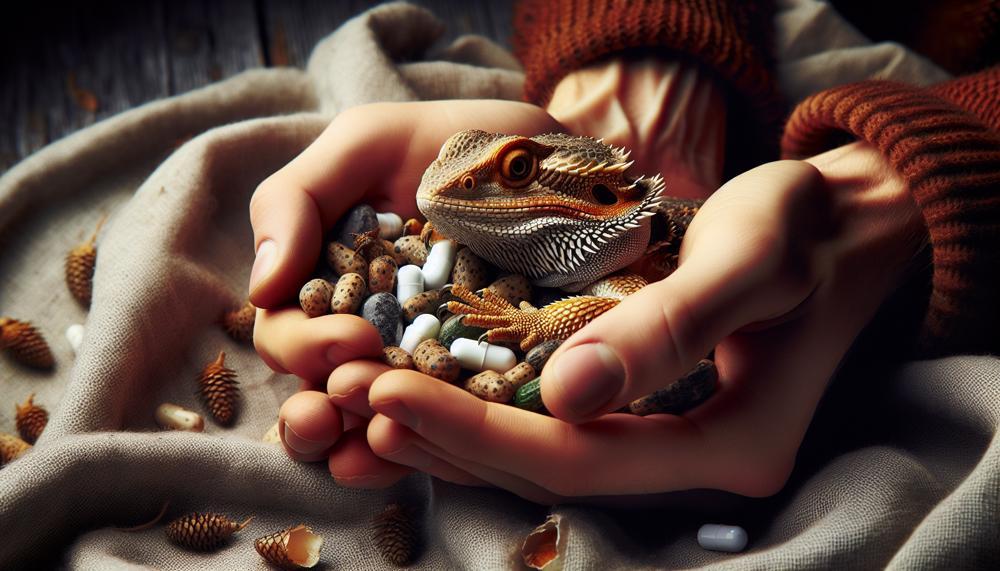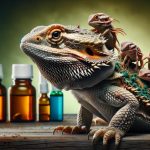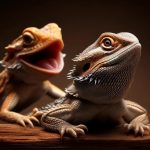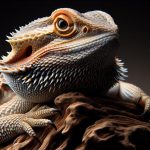Welcome to our blog post delving into the perplexing topic of why your beloved bearded dragon may have suddenly turned black and passed away.
As passionate reptile enthusiasts, we understand the deep bond that can form between owners and their unique pets. That’s why it was truly heartbreaking for us to witness our own bearded dragon’s unexpected color change and eventual passing.
In this post, we will explore the potential reasons behind this drastic transformation and offer some guidance on how to cope with such a loss. Here are the key points that we will cover:
- Bearded dragons are known for their vibrant hues, but what happens when they abruptly become pale or dark?
- The importance of closely monitoring your pet’s behavior and physical appearance for any signs of illness or distress.
- Common health ailments that can lead to changes in a bearded dragon’s color.
- How stress and environmental factors can also play a role in altering a bearded dragon’s appearance.
- Coping with the loss of a cherished pet and seeking support during this difficult time.
Our aim with this post is to shed light on the possible explanations behind your bearded dragon’s sudden color change while providing solace for those who have gone through a similar experience. Let us embark on this journey together as we delve into this complex subject.
Contents
- 1 Why Your Bearded Dragon Turned Black and Died
- 2 Why Did My Bearded Dragon Randomly Die?
- 3 Why Is My Bearded Dragon Black and Lethargic?
- 4 Why Is My Bearded Dragon Not Eating or Moving?
- 5 What to Do With a Bearded Dragon When It Dies?
- 6 What Does a Bearded Dragon Look Like When Its Sick?
- 7 Why Is My Bearded Dragon Black and Shaking?
- 8 How Do I Know if My Bearded Dragon Has Parasites?
- 9 Why Is My Bearded Dragon Turning Grey?
- 10 Why Is My Baby Bearded Dragon Getting Darker?
- 11 Conclusion
Why Your Bearded Dragon Turned Black and Died
There are numerous factors that can cause a bearded dragon to turn black and ultimately die, including stress, an inadequate diet, metabolic bone disease, respiratory infections, and impaction.
These issues can lead to a decrease in appetite, weight loss, and other symptoms that can eventually result in death if not addressed quickly. Bearded dragons are delicate creatures that require proper care and a suitable environment to thrive.
Below are some of the potential reasons why your bearded dragon may have turned black and passed away:
Stress:
Bearded dragons are sensitive creatures that can easily become stressed. Improper handling, loud noises, sudden changes in their environment, or aggressive tank mates can all cause stress in bearded dragons.
When under stress, they may turn black as a defensive mechanism. If the source of stress is not resolved, it can lead to other health problems and ultimately be fatal for a bearded dragon.
Poor Diet:
A poor diet lacking essential nutrients can weaken a bearded dragon’s immune system and make them more vulnerable to illnesses.
Additionally, certain food items can cause digestive issues or even poisoning in bearded dragons, which can result in them turning black and eventually passing away.
Metabolic Bone Disease (MBD):
MBD is a common condition in bearded dragons caused by a lack of calcium and Vitamin D3 in their diet.
This can lead to weak and brittle bones, deformities, neurological issues, seizures, and ultimately death. A bearded dragon turning black may be a sign of MBD due to the pain and discomfort caused by the disease.
Respiratory Infections:
Bearded dragons are prone to respiratory infections caused by bacteria, viruses, or fungi. These infections can affect their lungs and cause difficulty breathing, wheezing, excessive mucus production, and a darkening of their skin. If left untreated, respiratory infections can be fatal for bearded dragons.
Impaction:
Impaction occurs when a bearded dragon ingests something that is too large or indigestible, such as rocks, sand, or large prey items. This can cause a blockage in their digestive system, making it difficult for them to pass stool.
The trapped waste can put pressure on their organs and lead to complications, including darkening of the skin and death.
Why Did My Bearded Dragon Randomly Die?
Bearded dragons can often pass away unexpectedly without any clear signs of illness or injury.
This can be due to a variety of reasons, such as Metabolic Bone Disease, impaction, infections, egg binding, and vitamin toxicity.
Inadequate husbandry and improper nutrition can also play a role in sudden deaths among bearded dragons.
The first common cause is Metabolic Bone Disease, which can be prevented by providing a diverse diet supplemented with calcium and vitamin D3 powder, along with proper lighting. Impaction, another reason for sudden death, can be avoided by using safer alternatives for substrate, such as reptile cage carpet or newspaper.
Infections are also a common culprit in sudden deaths among bearded dragons. To prevent this, it is crucial to keep their enclosure clean and seek prompt veterinary care at any signs of infection. Egg binding, which occurs when a female is unable to lay her eggs properly, can also lead to sudden death. To prevent this, it is important to provide suitable nesting sites and ensure females have proper nutrition.
Vitamin toxicity is another potential cause of sudden death in bearded dragons. To prevent this, it is recommended to use supplements with beta carotene instead of vitamin A. Finally, inadequate husbandry and nutrition can contribute to sudden deaths among bearded dragons. Regular check-ups with a veterinarian and maintaining a balanced diet with leafy greens and varied feeder insects can help ensure a long and healthy life for these beloved reptiles.
It is crucial to provide a suitable habitat and proper care for bearded dragons to prevent these common causes of sudden death. This includes maintaining a clean and sanitary environment, offering a diverse and nutritious diet, and seeking veterinary care when necessary.
Why Is My Bearded Dragon Black and Lethargic?
There are multiple factors that can contribute to a bearded dragon displaying black skin and a lethargic demeanor.
These include feelings of fear, anger, sickness or infection, temperature regulation, adjusting to a new environment, courtship behavior, territorial behavior, discomfort with handling, post-brumation recovery, loneliness or attention-seeking behavior, and overall inadequate care.
Below is a table outlining these reasons and potential solutions for each:
| Reason | Description | Solution |
| Fear | Bearded dragons may turn black when they feel threatened or scared. | To alleviate fear, remove the source of stress and allow them time to calm down. |
| Anger | Bearded dragons may also display a black beard when they are irritated or angry. | Avoid triggering their anger and give them space to calm down. |
| Sickness | A black beard can be a sign of illness or infection in a bearded dragon. | If your bearded dragon shows signs of sickness or infection, seek prompt veterinary care and follow any recommended treatment plans. |
| Temperature Regulation | Bearded dragons may turn black to regulate their body temperature. | Ensure their habitat has a proper temperature gradient and provide a basking spot for them to regulate their body temperature as needed. |
| New Environment Adjustment | A new environment can be stressful for a bearded dragon, causing them to display a black beard. | Allow your bearded dragon time to acclimate to their new environment and avoid handling until they are more comfortable. |
| Courtship Behavior | In males, a black beard can indicate courtship behavior towards females. | If you have a male bearded dragon, provide appropriate housing and consider getting a female companion for them to direct their courtship behavior towards. |
| Territorial Behavior | Male bearded dragons may also display a black beard when defending their territory. | To avoid territorial conflicts, provide enough space for multiple males and avoid overcrowding in their habitat. |
| Discomfort with Handling | Sometimes, bearded dragons may turn black when they are uncomfortable with handling. | To make your bearded dragon more comfortable with handling, approach them gently and give them time to get used to being handled. |
Why Is My Bearded Dragon Not Eating or Moving?
There can be several reasons why your bearded dragon is showing a lack of appetite and mobility. These include changes in diet, temperature, lighting, or environment, as well as factors like brumation, impaction, shedding, reaching adulthood, and even parasitic infections or illnesses.
It is crucial to address these issues promptly to ensure the well-being of your beloved bearded dragon.
Diet Changes
Bearded dragons are known to be picky eaters. Any sudden changes in their diet can cause stress and discomfort, leading to a loss of appetite and energy.
It is important to provide a well-balanced diet consisting of 75% meat and 25% vegetables for juvenile dragons and 25% meat/75% vegetables for adults. This will help keep your dragon healthy and happy.
Temperature and Lighting
Proper temperature and lighting are essential for the overall health of your bearded dragon. Incorrect temperature levels or inadequate UVB lighting can disrupt their natural behavior, causing a suppressed appetite.
Make sure to provide adequate basking temperatures and UVB lighting for your dragon’s well-being.
Environmental Changes
Bearded dragons are sensitive creatures that can easily get stressed by changes in their environment.
These changes can affect their appetite and mobility. It is essential to provide a stable and comfortable environment with enough space for your dragon to thrive.
Brumation
Brumation is a form of hibernation that occurs in response to environmental changes or variations in daylight length.
During this time, bearded dragons may exhibit decreased appetite and activity levels. It is important to monitor them closely and provide appropriate care as needed.
Impaction
Impaction is a common issue that can occur due to an excess of sand or gravel in their diet.
This can lead to a loss of appetite and mobility. To prevent impaction, make sure to provide a proper substrate for your dragon and avoid feeding them loose substrate.
Shedding
Shedding is a natural process for bearded dragons, but it can be uncomfortable for them.
This discomfort can lead to a loss of appetite and decreased activity. Ensure proper humidity levels and provide a rough surface for your dragon to aid in shedding.
Reaching Adulthood
As bearded dragons reach adulthood, they may go through a period of decreased appetite and activity.
This is a normal part of their growth process. However, it is still important to monitor them closely and ensure they are receiving proper nutrition.
Parasites or Illnesses
Parasites or illnesses can also cause suppressed appetite in bearded dragons.
If you suspect your dragon is not feeling well, it is best to consult with a veterinarian for proper diagnosis and treatment.
Injuries
In rare cases, injuries can also cause a lack of appetite and mobility in bearded dragons.
If you notice any unusual behavior or changes in your dragon’s eating habits, it is best to seek professional help.
What to Do With a Bearded Dragon When It Dies?
| How to Properly Handle the Passing of a Bearded Dragon with Respect | Ways to Honor and Remember Your Bearded Dragon |
| Treat the body with care and respect, using gloves or a towel | Create a special memorial plaque or marker |
| Consider proper disposal methods, such as burial or cremation | Make a memory box filled with cherished mementos |
| Donate to reptile rescues in your bearded dragon’s name or volunteer in their honor | Share stories and experiences with others who have lost a bearded dragon |
| Bring joy and love back into your life by getting another bearded dragon |
Losing a bearded dragon can be a devastating experience, and it’s crucial to handle the situation with the utmost care and respect. This includes treating the body with gloves or a towel and choosing an appropriate method of disposal, such as burial or cremation.
Aside from handling the passing of a bearded dragon, there are also several ways to honor and remember them. These include creating a unique memorial plaque or marker, crafting a memory box filled with treasured mementos, and connecting with others who have also lost a beloved bearded dragon.
One meaningful way to honor your bearded dragon’s memory is by donating to reptile rescues or volunteering your time in their name. Not only does this support important causes, but it also keeps your pet’s memory alive through giving back.
Some may find comfort in getting another bearded dragon after their loss. Not only does this help cope with the grief, but it also pays tribute to the cherished memories of their previous pet by providing a loving home for another bearded dragon in need.
What Does a Bearded Dragon Look Like When Its Sick?
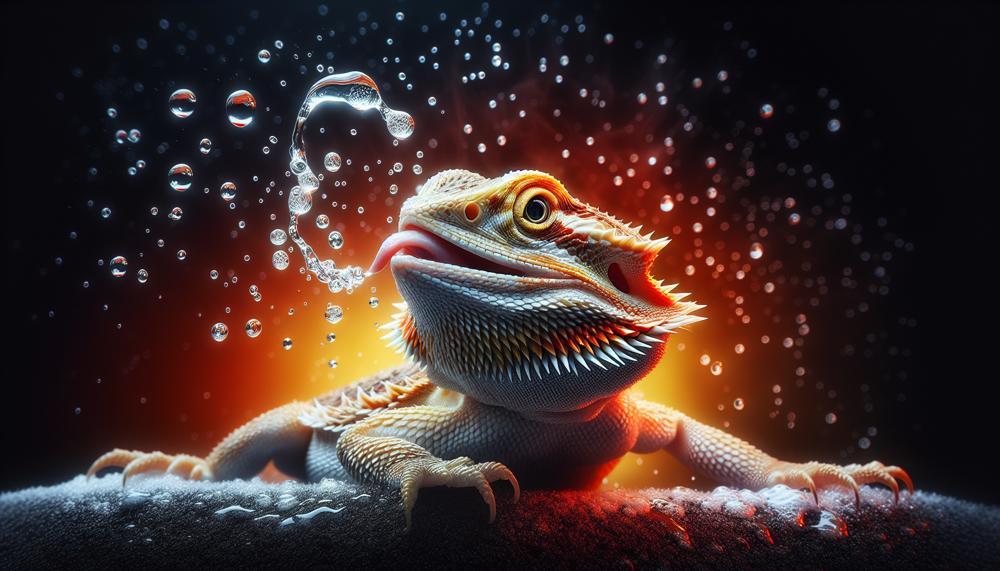
There are various indications and characteristics that can suggest if your bearded dragon is unwell. These may include physical and behavioral changes that are atypical for a healthy bearded dragon.
It is crucial to pay close attention to these signs and seek medical assistance when necessary, as early detection and treatment can greatly increase the chances of recovery.
- Altered Breathing: If your bearded dragon is experiencing wheezing, difficulty breathing, or any unusual sounds while inhaling or exhaling, it could be a sign of a respiratory infection or other underlying health issue.
- Mouth Secretions or Discoloration: Any secretions or discoloration from the mouth, such as excessive saliva or mucus, can be an indication of an underlying health problem.
- Reduced Mobility: Bearded dragons are typically active and inquisitive creatures. If you notice a sudden decrease in movement or extreme lethargy, it could be a sign of sickness.
- Loss of Appetite or Weight Loss: A healthy bearded dragon is known for its vigorous appetite. If your dragon has stopped eating or has lost weight, it could be a sign of illness.
- Eye Swelling or Sunken Eyes: Swollen eyes or sunken eyes can be symptoms of various health issues, including dehydration, infection, or parasites.
- Anomalous Body Shape: Bearded dragons should have a straight and robust body shape. If you notice any kinks in their tail or back, soft bones, drooping jaw, or weakened limbs, it could be a sign of metabolic bone disease (MBD) or other health concerns.
- Changes in Feces: Keep an eye on your bearded dragon’s poop as it can reveal a lot about their health. If it is extremely odorous, runny, or bloody, it could indicate an internal infection or other digestive issues.
- Unusual Movements: If your bearded dragon is experiencing jerky movements, twitching, or seizures, it could be a sign of neurological problems.
- Skin Issues: Decaying or discolored skin can be a sign of infection or other health concerns.
If any of these signs or symptoms are noticeable in your bearded dragon, it is essential to seek medical attention from a reptile veterinarian. They will be able to accurately diagnose and treat your dragon to ensure their overall well-being.
Why Is My Bearded Dragon Black and Shaking?
This behavior can indicate a variety of issues such as stress, temperature regulation, or underlying health concerns. In order to properly care for your pet, it is important to identify the potential cause and take appropriate action.
Stress is a common reason for bearded dragons to turn black and shake. If you notice this behavior in your pet, try to determine the source of their stress and remove it if possible. Additionally, adjusting the temperature in their enclosure can help regulate their body temperature and reduce this behavior.
However, if these measures do not improve the situation or if your bearded dragon appears to be in discomfort, it is best to seek veterinary attention.
A veterinarian who specializes in exotic animals will be able to perform a thorough examination and provide appropriate treatment if necessary.
How Do I Know if My Bearded Dragon Has Parasites?
Bearded dragons, like most reptiles, are at risk of parasites, which can bring about various symptoms that may indicate their presence.
These include tiny white worms in the feces, weight loss, small black or red spots on the dragon’s body or enclosure, scratching or rubbing against objects, loss of appetite or energy, pale gums or eyes, and scabs or wounds on the skin. It is crucial to regularly check for these signs and seek veterinary attention if they are observed.
Annual fecal examinations can also help detect parasites in bearded dragons that may not display any visible symptoms.
If your bearded dragon is experiencing any of these indications, it is imperative to take action and seek proper treatment to ensure their health and well-being.
Why Is My Bearded Dragon Turning Grey?
There are numerous possible reasons for the greying of your bearded dragon. It could be a natural color change influenced by hormonal factors or seasonal changes. However, it could also indicate stress, a poor diet, genetics, injury, infection, or even cancer.
It is essential to address this issue as soon as possible if you notice your bearded dragon turning grey.
Natural color change:
Like many other reptiles, bearded dragons can change their skin color for various reasons.
This can be due to hormonal changes in their body or the changing of seasons.
Shedding:
Shedding is a natural process wherein reptiles shed their old skin to make way for new growth.
During this process, their skin may appear grey or dull before being shed completely.
Stress:
Environmental changes or improper handling can cause stress in bearded dragons, leading to a change in skin color.
If your dragon is turning grey due to stress, it is crucial to identify and address the source of stress.
Improper diet:
A deficient diet lacking in essential nutrients can also cause a bearded dragon’s skin to turn grey.
Ensure your dragon receives a balanced and varied diet to maintain its health and appearance.
Genetics and aging:
Similar to humans, bearded dragons experience changes in appearance as they age.
This can include alterations in skin color due to genetics or natural aging processes.
Health issues:
Injury, infection, malnutrition, or even cancer can cause a bearded dragon’s skin to turn grey.
Seek veterinary assistance if you notice sudden or significant changes in your dragon’s skin color for proper diagnosis and treatment.
Addressing the Issue
If your bearded dragon is turning grey due to stress or an improper diet, it is best to make changes in their environment and diet. This may involve providing a suitable habitat, reducing handling, and offering a balanced and varied diet.
If the cause of the grey coloration is due to a health issue, it is vital to seek veterinary care immediately.
A veterinarian can accurately diagnose and treat any underlying health problems that may be causing the change in skin color.
Why Is My Baby Bearded Dragon Getting Darker?
Bearded dragons, like most reptiles, have the remarkable ability to alter their color for different reasons. As baby bearded dragons grow and develop, they may experience changes in color that can either be natural or a sign of underlying issues such as stress, poor diet, or health concerns.
One possible reason for a baby bearded dragon’s color changing and getting darker is due to changes in the seasons. Bearded dragons are ectothermic creatures, which means that their body temperature is regulated by their environment. As the weather shifts, so does the temperature and lighting in their surroundings, which can impact their coloration.
Another factor that can cause color changes in baby bearded dragons is social signaling. These lizards have a complex communication system and may alter their color to convey dominance or submission to other bearded dragons.
Thermoregulation is yet another aspect that can result in color changes in baby bearded dragons. They may darken their color to absorb more heat from the sun or lighten their color to release excess heat.
Camouflage is also a possible explanation for a baby bearded dragon’s darkening color. In the wild, these lizards use their color to blend in with their surroundings and avoid predators.
Shedding is a natural process for all reptiles, and this can also cause temporary darkening of the skin. As the old skin sheds off, the new skin underneath may appear darker until it has fully shed off.
A baby bearded dragon’s age can also play a role in their changing color. As they mature, their pigmentation may deepen and become darker.
Changes in temperature can also affect a baby bearded dragon’s color. As mentioned earlier, these lizards are ectothermic and rely on external heat sources to regulate their body temperature. If the temperature drops too low, they may darken their color to absorb more heat.
Lastly, stress can also cause a baby bearded dragon’s color to darken. This can be a result of changes in their environment, handling, or illness.
Also Read: When Do Bearded Dragons Shed?
Conclusion
In conclusion, the unexpected darkening and passing of a bearded dragon can be a devastating experience for any owner. As we have explored in this post, there are various factors that may contribute to this tragic event, such as stress, inadequate nutrition, health issues, and environmental conditions. It is essential to closely monitor your pet’s behavior and physical appearance for any signs of distress or illness and seek immediate veterinary care.
Losing a cherished pet can be an emotionally challenging journey. It is crucial to take time to grieve and find support from others who have also experienced such a loss. Finding ways to honor your bearded dragon’s memory through creating memorials or volunteering can bring comfort during this difficult time.
Proper care and attention are vital for the well-being of bearded dragons. By understanding the potential causes behind their sudden color change and taking necessary precautions, we can ensure a happy and healthy life for these unique creatures.

